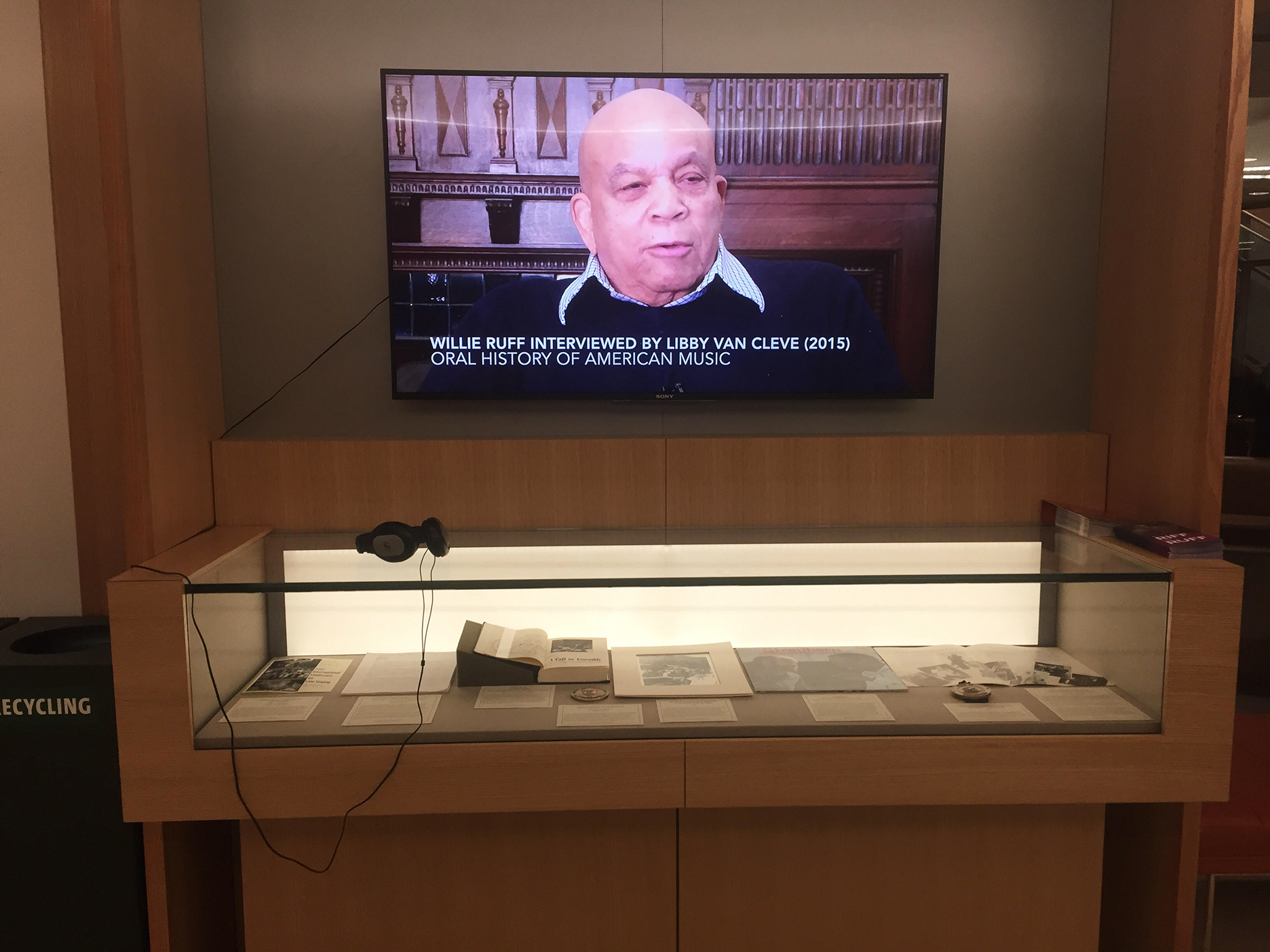
Christening the newly renovated Irving S. Gilmore Music Library in Sterling Memorial Library is the exhibit, “A Riff on Ruff” located just outside the Music Library. The exhibit, open since January 27, honors the 85th birthday of Yale alumnus and professor as well as world-renowned musician, professor Willie Ruff ’53 MUS ’54. Ruff, who plays French horn and bass, has been a School of Music faculty member since 1971 and an integral part of the wider jazz community.
The exhibit commemorates Ruff’s life, achievements and contributions to Yale with a multimedia collection of items and images, some on loan from Ruff himself. These are complemented with audio and video recordings of his interviews, conducted by Jack Vees in 1978 and Libby Van Cleve in 2015 for the Oral History of American Music, playing on the screens above the two display cases. Headphones accompany the screens so that viewers may get a sense of the energetic and good-natured personality for which he is also well known.
Through the interviews, Ruff gives an impression of how his musical career began. He cites his experiences in his hometown of Sheffield, Alabama as encouraging his development as a musician, where the influential jazz artist W.C. Handy visited Ruff’s elementary school class. Ruff, already a drummer, learned to play horn when he joined the Tuskegee Airmen in World War II, before pursuing music and pre-med at Yale.
Throughout his life, Ruff has brushed shoulders with many musicians well known for being at the vanguard of jazz music. In his interview, he mentions that he and Dwike Mitchell (The Mitchell-Ruff Duo) opened for famous jazz musicians including Louis Armstrong, Ella Fitzgerald, Lena Horne and Duke Ellington. The display also includes an LP composed by Billy Strayhorn and performed by the Mitchell-Ruff Duo. Duke Ellington consulted on early stages of production. Another notable moment of Ruff’s career highlighted in the exhibit is a photograph of himself and Mitchell on the Great Wall of China. The Duo traveled to China in 1981 to introduce jazz to new audiences. Ruff, remarkably, learned Chinese quickly enough to give a lecture-concert. They had also performed with the Yale Russian Chorus in the Soviet Union during the Cold War in 1959 for the same purpose.
Ruff has used his passion, talents and professional experiences to contribute greatly to the Yale School of Music. The Oral History of American Music has a wealth of interviews and videos conducted by and featuring Ruff in its collection. Alongside a flyer for the Duke Ellington Fellowship, an endowed program that Ruff founded, the exhibit notes that Ruff brought many notable musicians such as Ellington himself, Eubie Blake, Mary Lou Williams and Willie Smith to Yale to perform for and teach students at Yale and New Haven public schools. It also mentions that from 2005 to 2007, Ruff facilitated international conferences on line singing, fascinated by the fact that the traditional form of church singing was still being practiced in a diverse array of churches around the country.
One of Ruff’s most interesting accomplishments at Yale is a realization of Kepler’s planetary orbit harmonies done in conjunction with geology professor John Rogers and computer programmer Mark Rosenberg. The collection is a testament to Ruff’s impressive career, marked by unceasing innovation.
The exhibit also features prizes awarded to Ruff throughout his career. In 2000, he was granted the Connecticut Commission on the Arts Governor’s Arts Award. Thirteen years later the Yale School of Music awarded the Samuel Simons Sanford Medal to Ruff at commencement. It is one of the most prestigious medals awarded by the School of Music; among those awarded are Yo-Yo Ma and Virgil Thomson.
Listening to the interviews and viewing the rich exhibit, one gets a sense of the profundity of Ruff’s career and contributions to Yale. It is interesting to see how connected Yale has been to jazz culture. It seems that such an influential figure both in Yale music and the greater music narrative would merit a larger or more noticeable or more comprehensive display. The items on display and ever playing interview held in the hallway’s glass cases don’t stop a passerby from just passing by, rather than stopping and learning a thing or two about a truly distinguished Yale professor.







